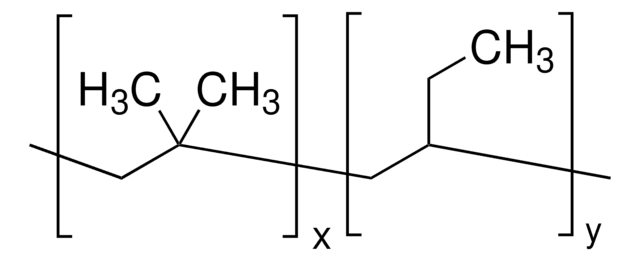すべての画像(1)
About This Item
化学式:
[-CH2C(CH3)2-]x[-CH2CH(C2H5)-]y
CAS番号:
MDL番号:
UNSPSCコード:
12162002
PubChem Substance ID:
NACRES:
NA.23
おすすめの製品
アプリケーション
Hydrophobic material is derivatized to make detergents and anti-rust additives. Adds tack, flexibility and water repellency to adhesives and coatings. Contributes ′cling′ to LLDPE films. Plasticizer for polymers, lubricants and metal-working fluids.
特徴および利点
Tackiness increases with molecular weight. Some internal double bonds may be present.
物理的形状
Terminal vinyl group.
その他情報
remainder 1- and 2-butenes
シグナルワード
Danger
危険有害性情報
危険有害性の分類
Asp. Tox. 1 - Skin Irrit. 2
保管分類コード
10 - Combustible liquids
WGK
WGK 1
引火点(°F)
159.8 °F - closed cup
引火点(℃)
71 °C - closed cup
個人用保護具 (PPE)
Eyeshields, Gloves
適用法令
試験研究用途を考慮した関連法令を主に挙げております。化学物質以外については、一部の情報のみ提供しています。 製品を安全かつ合法的に使用することは、使用者の義務です。最新情報により修正される場合があります。WEBの反映には時間を要することがあるため、適宜SDSをご参照ください。
消防法
第4類:引火性液体
第三石油類
危険等級III
非水溶性液体
Jan Code
388696-VAR:
388696-BULK:
388696-100ML:
388696-1L:
試験成績書(COA)
製品のロット番号・バッチ番号を入力して、試験成績書(COA) を検索できます。ロット番号・バッチ番号は、製品ラベルに「Lot」または「Batch」に続いて記載されています。
この製品を見ている人はこちらもチェック
Syutaro Yamamoto et al.
Journal of oleo science, 56(9), 463-469 (2007-09-28)
Water-soluble metal working fluids are used for processing of aluminum alloy materials. This short article describes properties of new additives in water-soluble metal working fluids for aluminum alloy materials. Many half esters or diesters were prepared from the reactions of
Huaiyu Wang et al.
Acta biomaterialia, 5(1), 279-287 (2008-09-02)
Poly(butylene succinate) (PBSu), a novel biodegradable aliphatic polyester with excellent processability and mechanical properties, is a promising substance for bone and cartilage repair. However, it typically suffers from insufficient biocompatibility and bioactivity after implantation into the human body. In this
X Y Wu et al.
The British journal of ophthalmology, 82(5), 569-576 (1998-08-26)
The goal was to compare the biological response of the corneal stroma with three porous materials: a melt blown microfibre web of polybutylene:polypropylene (80:20); a polyester spun laced fabric (polyethylene terephthalate), and an expanded polytetrafluoroethylene. Fifty per cent of each
M Risbud et al.
Biomaterials, 22(12), 1591-1597 (2001-05-26)
The aim of the study was to prepare composites of poly(butylene terepthalate)/wollastonite (PBT/W), evaluate their properties and in vitro biocompatibility. Composites of PBT with wollastonite in two different proportions, viz. 70/30 (PW-30), 50/50 (PW-50) were prepared. The DSC studies indicate
Anders Höglund et al.
Macromolecular bioscience, 12(2), 260-268 (2011-11-19)
The pre-polymer poly(but-2-ene-1,4-diyl malonate) (PBM) and a series of PBM-based materials are shown to be degradable under physiological conditions in vitro and they are therefore presented as potential materials for biomedical applications. Four different PBM-based materials are synthesized: a PBM
ライフサイエンス、有機合成、材料科学、クロマトグラフィー、分析など、あらゆる分野の研究に経験のあるメンバーがおります。.
製品に関するお問い合わせはこちら(テクニカルサービス)















